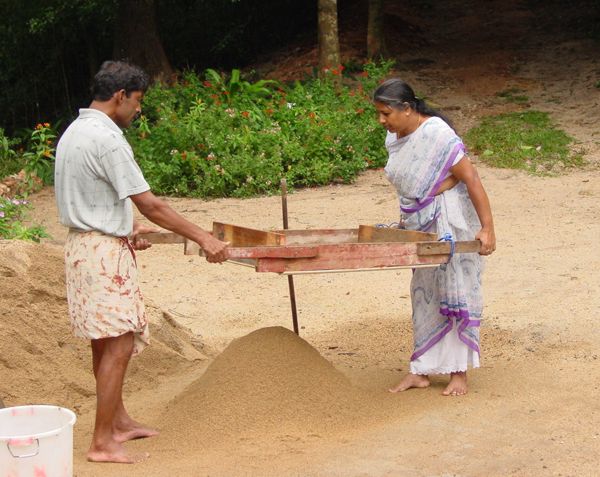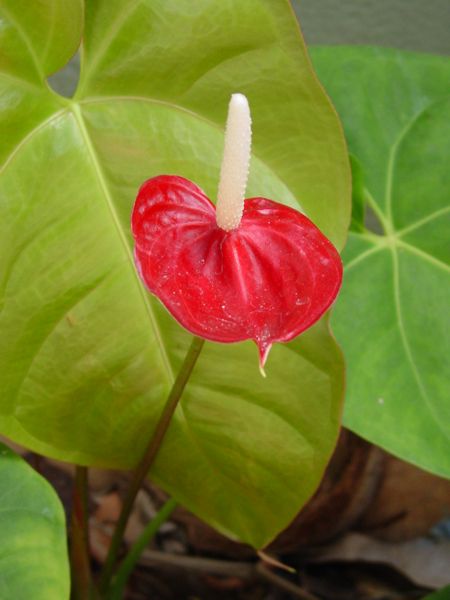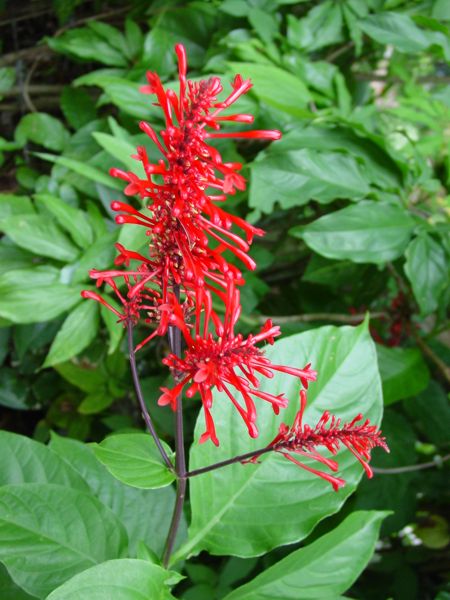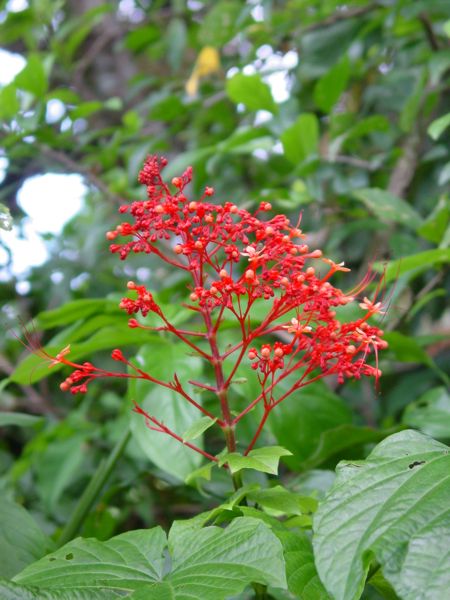
The Pearl Diver Wears a Raincoat, June 2, 2006
Friend Bruce's correction came within mere minutes. Our mistake! Those were not hummingbirds, after all. Bonafide hummingbirds are found only in North and South America. In Japan, there is a moth that seems to think he's a hummingbird, that's able to fool a lot of people into thinking likewise, but is still just a moth. In Sri Lanka, we have some wonderful birds, including those who act a lot like hummingbirds. Do check out this wonderful website and you'll see why we were fooled.
 |
|
| Purple-rumped sunbird | |
Our unfortunate birds may have been cheated of their family by a squirrel invading their nest, but the next day Lily related how a squirrel family at her house was completely destroyed by a troop of monkeys who devoured the whole lot. It seems that it is not just a dog-eat-dog world, but an everybody-eat-everybody-else sort of place.
The stray dogs in Anniwatte keep increasing. People drop off unwanted pups, plus there is a whole lot of breeding going on. One mother had a cute little puppy, but it was so predictable that it would be hit by a car, and--it was. She couldn't accept that her baby was dead, so she carried its body to the side of the road and howled and mourned all through the night. She wouldn't let anybody near her little dead puppy. This went on for days until, finally, the people who live at the top of the driveway chased her away and made a funeral pyre of coconut husks and cremated it.
This is the Buddha Jayanti, 2550 years ago Buddha passed into Parinibbana. We've gotten e-mails from our students in India who were able to be at BuddhaGaya for the ceremonies. For the Vesak full moon we went to Vajiraramaya to worship the relics on display in the pagoda. This is a relatively new temple, high, high, high up above Kandy. There were many people there, some of whom had been keeping eight precepts and meditating all day. As usual in Sri Lanka this was an occasion for ceremonial drumming, so we all waited for the musicians to arrive. We hope this tradition never dies out.
The next night, we spent a good five hours going around Peradeniya and Kandy looking at the beautiful paper lanterns and pandals on display. There were massive crowds, and no untoward incidents, but when we got home we just wiped our faces with a towel and left it black. There was an awful lot of air pollution from all the special buses, flatbed trucks, and three wheelers taking people around to enjoy the spectacle. (These photos are already on the website for all to see.)
<http://www.brelief.org/reports/vesak01.htm>
Our new class at Vajiraramaya is wonderful. We meet in the library, and they are right there waiting for us, even though we're always early. Last time (second class), we had two new students. One is a novice from Mongolia, who has been some years here already and, thus, speaks good Sinhalese. The other is a young man from Mexico, who hopes to ordain soon. We looked for Dhamma materials in Spanish for Luis Filipe, and it's remarkable how much is available online!
Although there was virtually nothing in the papers prior to the event, some activities were organized in Colombo for the Buddha Jayanti visit of Ven. Bhikkhu Bodhi, Goenka, and other award recipients. In the morning, there was a special seminar, and Bikkhu Bodhi made a two-hour speech. It was brilliant, of course.
The day before he gave the speech, he was writing away in his hotel room, when a devotee called. It was a woman who had repeatedly asked if she could offer anything, and he had always insisted there was nothing he needed. This time, however, he did need something. He asked whether she happened to have a computer at her house. She answered that she did, but that she only used it for e-mail, and that she didn't even know how to turn it on. He asked whether he might be able to use it. She was delighted at last to be able to offer something. She asked when they should pick him up, and he answered, "Right now." He spent the next few hours typing, cutting and pasting, and printing, but it all worked out beautifully. Everyone was happy!
The next day, the morning program went off fine, but the person in charge forgot to pick him up to take him to the evening reception where he was actually scheduled to receive the government award he had been invited to Sri Lanka to get. Of course, not wanting to cause difficulties, he just waited. He never mentioned it to anybody, and no one would have known had a reporter for one newspaper not picked up the story. It was on the front page of that daily the next day. What does that tell you about the monk?! To make up for lapse, the president had a special meeting the day before he flew out and gave him the award then. Still, what a faux pas!
We had another chance to offer lunch to Ven. Bhikkhu Bodhi when he came back for a few days in Kandy with some Americans from Bodhi Monastery in New Jersey. Savithri had asked him after his last lecture whether it would be possible to see him again one last time, and he mentioned that he would be visiting the Forest Hermitage on May 20, to pick up a few things he wanted to take back to the US. Ironically, he himself had forgotten that he'd said that, but there he was, and the lunch was wonderful. We hired a van so that everyone who wanted to join could go along and share the merit. As always, the ride into Udawattekelle, the national park right in the middle of Kandy, was spectacular. Our driver had to sign at the gate. (Ordinarily, vehicles are not allowed to enter the park.) Rain or shine, the forest has plenty of courting couples, seeking privacy to whisper sweet nothings. So much so that the monks have put up signs saying that couples should not take the path to the hermitage, but confine their romantic walks to other parts of the park. The way to the hermitage has some very dramatic scenery, but our favorite spot is a bend in the road where some huge creepers, which intertwined themselves seemingly centuries ago, hang twisted overhead. Not far from the entrance, there is a large pond that should by all rights be filled with crocodiles, but we have seen nothing in it. There is a lot of other wildlife in the park--tiny mouse deer, rabbits, porcupines, monkeys galore, and ... leeches.
 |
 |
||
| At Udawattekelle, Lily pitched in to help the workmen who were tiling the hermitage, but she got blisters for it. | Visakha washing dishes; our water filter | ||
Speaking of wildlife, we share our house with a wide variety of critters. Recently we had a mouse in the closet. This time it was Lily to the rescue; she chased him out and thoroughly cleaned up after the blighter. Wild beasties know that the rainy season is coming on, so it behooves them to find a nice and comfy spot in which to stay high and dry, but not our closets, please!
 |
 |
 |
 |
|
| Flowers in our garden; left is anthurium | ||||
We have to admit that the timing was excellent. In February, our MI Peace friend Ruth from Lapeer took it upon herself to send us some Tupperware. We didn't need it so much in February or March or April, but now, with vermin trying to move in on us, all these great containers are perfect for keeping them out of the food in the cupboard. Lily was delighted and quickly learned how to seal all the containers properly.
Also in the box was a CD from Pat with a zillion photos of MI Peace. Talk about nostalgia! We could just feel the cold, the snow, the icy rain, as people walked along the shoveled paths of the Triangle. We were amazed to see how many people have been turning out--and the signs just keep going on, with new ones added here and there. It was awful to realize that we could date the demonstrations by the rising death toll on the posters in the pictures. Don't we wish we could just roll it back to the day before the war started and give everybody a second chance! Now we read of the possibility of attacking Iran, with nuclear weapons! It gives us shivers of fear for the world, especially the little kids.
 |
 |
 |
 |
|||
 |
 |
|||||
|
Michigan Citizens for Peace
An all-weather group In the bottom two rows, |
||||||
 |
 |
 |
 |
|||
 |
 |
 |
 |
|||
 |
 |
 |
 |
|||
We recently read that Chris Matthews was saying something like, "If people were so against the war, why weren't the streets full of demonstrators?" Well, Miller and Ballenger has been the scene of protests for how long now? Since September 2002!
It finally happened. The EU declared the Tamil Tigers terrorists, at last. We hadn't believed Lily when she said that the Tiger leaders were Christian, but there it was in the newspapers, in black and white, suggesting that the Christian clergy should talk to them about the ten commandments and suffer the little children.... We hardly imagine that that would make a difference, since these men are intoxicated with power (which flows from the barrel of a gun) and in love with bloodshed (which flows after a claymore mine blast). We have to hope that the terrorist designation will at least dry up some of the funds the Tigers get from the West and reduce their weapons purchasing power. It's probably too much to hope that it will drive them to peace talks later this month, but hope we will.
We went swimming one recent afternoon, at the hotel down the way. Just as we finished and were drying off, the heavy rain started. Mind you we were wet from swimming, but on the way home, a fellow pedestrian offered to share his umbrella. We thanked him, but refused his generosity. There is a limit to how wet one can get. After you're soaked to the skin, you can't get any wetter, which reminded us of the old Japanese proverb: "The pearl diver wears a raincoat to work!"
In our last report, we mentioned the natural sounds that Ven. Sumedha uses with hospital patients. We got much more that we'd ever expected. One CD from Jason has hours of wonderful sounds, including humpback whale songs and an amazing recording of whales sounding! As Ven. Sumedha put it, "just imagining people listening to whale song brings a smile." When he played the bird songs, flocks of birds flew into his cave to join the chorus! He is very pleased and the ICU patients will be much comforted. Many thanks!
The other night we drank some fruit juice that Lily squeezed for us. We're not sure what fruit it is, but we think is is "vilva," (Bengal quince) a fruit mentioned by Buddha, particularly in "The Sound the Hare Heard" (<http://www.accesstoinsight.org/lib/authors/kawasaki/bl142.html#jat322>).
The juice is quite thick and full of pulp. Well, we left about a half a glass sitting on the kitchen counter all night. The next morning, Ken picked up the glass and said to himself, "Gee, those seeds are really big. I don't remember such big seeds in what I drank last night." He poured the juice into the sink, and what he thought were seeds were heads attached to bodies which scurried to get away. They were three very traumatized gekkos. We don't know how many hours they had been trapped in the juice, standing on tiptoes to keep from drowning. The poor little things were apparently OK, but we really must be more careful next time. We will be, we promise!
It's official. The weather we are having is perfectly normal. The monsoonal rains have begun, and we will have rain (on and off) until September. There will be a few days of sun in there, according to the newspaper, but, by and large, there will be lots of rain. This is the season of landslips, so be alert!
For a few days the newspapers were filled with articles about the banning in Sri Lanka by President Rajapakse of the movie, "The DaVinci Code." We had to chuckle when the Bishop of Colombo prefaced his expression of gratitude to the President by saying, "Of course, the Catholic church has always strongly defended freedom of expression." A few days later, we read that when the Pope visited Auschvitz for a recent ceremony, he asked, "Where was God?" Shouldn't one more properly ask, "Where was the Pope?"
In India, we bought a tube of toothpaste called "Neem," (pure vegetarian. as it says right on the tube!) It is wonderful. We have asked our local super to try to get it. We remember hearing years ago that Buddha recommended twigs from the neem tree be used as "toothsticks" for cleaning. This article was recently in one of the local dailies here in Sri Lanka. We would like to share:
NEEM: tree of life
Anna Horsburgh Porter
 |
||
| A neem tree in India | ||
Ancient medicine: The neem (kohomba, in Sinhala) tree grows prolifically throughout South Asia, especially in India, Sri Lanka, and Burma. Its medicinal properties have been known for thousands of years--and its uses are so varied that this tree is called the "village pharmacy" of South Asia.
Recently, there has been a growing interest from the international agro-chemical business over the potential of neem as an organic alternative to industrial pesticides.
Patents on the use of neem have been taken out by international companies, one of which was at the center of a 10-year court battle. An international group led by the Indian environmentalist Dr. Vandana Shiva took the case to the European Patent Office, claiming that you can't patent ancient knowledge and calling it bio-piracy.
"We wanted to reveal what bio-piracy is, this patenting of indigenous knowledge and bio-diversity," she says. "We thought a patent that's held by the biggest superpower of the world and one of the biggest chemical giants would be an effective patent to take on."
The patent was revoked. In the villages of Rajasthan near Jodhpur, the neem tree is still essential to daily life. A large neem tree usually stands in the center of each village, providing shade and cool underneath its branches--it is said that the temperature under a neem tree is always two or three degrees cooler than in any other shade.
When the British laid out the Indian capital, New Delhi, at the beginning of the last century, they planted avenues of neem as a natural air conditioner for the new city.
The traditional uses of neem are many and varied. When a child has a fever or chickenpox, neem leaves are put on the bed. For eczema, psoriasis, ulcers, or any other skin problems, a paste of neem bark or leaves is made up and applied directly to the skin. When winter clothes are put away for the summer, neem leaves are put between them to keep away moths, and its leaves are boiled to make a bitter drink to cure worms and diarrhoea. Animals eat neem leaves as fodder in this desert climate where little else grows, and the seeds of the fruit are ground to make a natural pesticide.
The tree is so crucial to life in India that the Hindu villagers worship it as a god and tell the story of Lord Krishna comparing himself as a god amongst men to the neem tree as a god amongst trees.
Perhaps the most prolific use of the neem tree throughout India is as a natural antiseptic toothbrush. People break off a small twig, peel off the bark, and chew one end of the twig into a soft brush, which they then rub around the gums and teeth. Finally, they split the twig in two and use the flat hard surface to scrape their tongues. The most valuable part of neem for modern scientific research is the oil produced from pressing the neem kernel.
Scientists call the active ingredient in this oil azadirachtin <http://www.lclark.edu/~esm/neem/azadirachtin.html>) --and the strength and quality of this is central to using neem as a pesticide or fungicide. Dr. Ramesh Saxena, head of the Neem Foundation in India, has pioneered the use of neem as a natural pesticide in South Asia, the Philippines, East Africa, and Australia. (From News Today, Bangladesh)
We thought you should know!